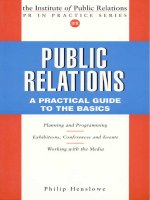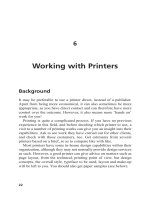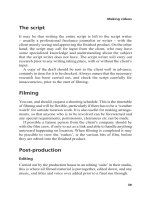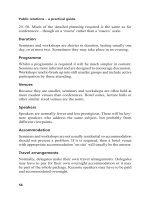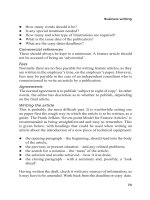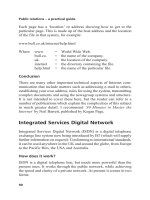Public relations a practical guide to the basics_5 pptx
Bạn đang xem bản rút gọn của tài liệu. Xem và tải ngay bản đầy đủ của tài liệu tại đây (147.36 KB, 17 trang )
Public relations – a practical guide
56
2550. Much of the detailed planning required is the same as for
conferences though on a micro rather than a macro scale.
Duration
Seminars and workshops are shorter in duration, lasting usually one
day, or at most two. Sometimes they may take place in an evening.
Programme
Whilst a programme is required it will be much simpler in content.
Sessions are more informal and are designed to encourage discussion.
Workshops tend to break up into still smaller groups and include active
participation by those attending.
Venues
Because they are smaller, seminars and workshops are often held at
more modest venues than conferences. Hotel suites, lecture halls or
other similar sized venues are the norm.
Speakers
Speakers are normally fewer and less prestigious. There will be key-
note speakers who address the same subject, but probably from
different viewpoints.
Accommodation
Seminars and workshops are not usually residential so accommodation
should not present a problem. If it is required, then a hotel venue
with appropriate accommodation on site will usually be the answer.
Travel arrangements
Normally, delegates make their own travel arrangements. Delegates
may have to pay for their own overnight accommodation or it may
be part of the whole package. Keynote speakers may have to be paid
and accommodated overnight.
319(11).p65 13/06/00, 12:3256
57
Promotions and functions
Fees and expenses
Delegates to seminars and workshops normally pay a fee and keynote
speakers may have to be paid, though less than for a conference.
Overall, expenses will be less.
Equipment
The same rules apply here as for a conference, though on a smaller
scale. Many hotels will provide all the equipment necessary for audio-
visual presentations and even video and PA equipment. However,
check it all out first. It may not be very good, or it may be faulty.
And they may charge extra for using it!
319(11).p65 13/06/00, 12:3257
Public relations – a practical guide
58
12
Visits
All types of visits require a degree of planning and organizing, depend-
ing on the nature of the visit and the status of the visitor. Getting all
the details right, so that the visit is a success, is one of the principal
roles of public relations, be it for a client or in-house for ones own
organization. A successful visit can do wonders for the reputation
and the image of the organization concerned, by placing it firmly in
the public eye and giving it, and often its work, a very high profile.
Reputations, however, can be made and destroyed by the success
or otherwise of a visit.
If the guest of honour is a VIP, such as a member of the Royal
Family, a politician, a civic or other dignitary, special considerations
may have to be taken into account. Advice on how to handle such
visits is given below.
Some general rules will apply to all types of visit, with detailed
differences depending on the circumstances. Before any visit you will
need to gather as much detailed information as you can so that your
planning can begin.
319(12).p65 13/06/00, 12:4858
59
Visits
VIP visits
Two overriding characteristics of VIP visits are the timetabling that
has to be adhered to and, in certain cases, the security measures
required. There will also be, inevitably, some level of protocol to be
observed. Matters also arise such as who should greet the VIP, how
the visitor is to be addressed, what precedence takes place in any
procession etc. (See also Appendix 9.)
Foreign VIPs
When foreign VIPs such as ambassadors or diplomats are involved,
appropriate liaison and some forward planning is additionally required.
You may also need input from local organizations, such as the police
and the local authority in the area of the visit, with whom you should
liaise over the details of the visit.
Your particular visit may only be one part of a much longer, more
widespread visit by the VIP concerned, who may well be going to
several other locations in the area or region. Do not forget to alert the
Central Office of Information, which may want details of the proposed
visit so as to be able to alert appropriate overseas media.
Royal visits
Here, security is usually the main consideration, and there will be a
number of other agencies and organizations who will be involved.
These will include either Buckingham Palace or Kensington Palace,
the countys Lieutenancy Office and the Lord-Lieutenant, the police
and the various mayoral offices at the local town halls. There may
be other host organizations with which you should discuss the part
they will play in the visit. (For details see Appendix 10).
319(12).p65 13/06/00, 12:4859
Public relations – a practical guide
60
13
Sponsorship and
Educational Activities
Sponsorship is really a logical development of the old fashioned
patronage. The latter term is still used on occasions, but sponsorship
is the term more commonly used today. A patron is described in the
dictionary as someone who countenances, supports, protects or gives
influence to [an individual]. Sponsorship is described as being a
business deal which is intended to be to the advantage of both the
sponsor and the sponsored a separate element of marketing. The
principle of sponsorship is the same as that of patronage, but it is no
longer confined to one person.
Patronage
In the past monarchs, the church and the aristocracy in other words
the rich both in this country and in Europe, were usually the main
patrons. They were benefactors of the arts in general, mostly for
philanthropic reasons. For example, the painter Michelangelo was
sponsored by the Pope to paint the roof of the Sistine Chapel in Rome,
and many other notable European Renaissance painters enjoyed
wealthy patronage from the aristocracy and the church.
319(13).p65 13/06/00, 12:4960
61
Sponsorship and educational activities
In this country monarchs have, at various times, sponsored artists,
such as Van Dyke and Sir Peter Lely, as well as writers and musicians.
The composer Handel was frequently sponsored by different members
of the aristocracy and royalty, among whom were such notables as
the Duke of Chandos and George I, the latter both when he was the
Elector of Hanover and later when he became King of England.
Sponsorship
This is the provision of resources (either in cash or kind) for an
independent activity, in return for the benefits which it is anticipated
will accrue by virtue of that support.
There are many examples of sponsorship today. They range from
sponsoring the individual performance of a play, concert or opera, to
sponsorship of a Premier League football team for a whole season, a
national rugby or cricket team tour, an international sporting fixture,
local junior teams or even a local competition of some sort.
Sponsorship today is not only given for altruistic purposes, but also
for sound commercial reasons. On the whole, the days of very wealthy
individuals who would sponsor a musician, a writer or an artist are
long gone; nowadays there are different, and differing, reasons for
sponsorship: usually either philanthropic, strictly commercial, or a
mixture of both.
Philanthropy
There have been many famous philanthropists in the last one hundred
years, both in this country and the USA. They include John D.
Rockefeller, Dale Carnegie (who founded free libraries in both
England and Ireland), Sir Joseph Lever (the soap manufacturer who
created the Lever Art Gallery), and George Cadbury (who sponsored
adult education and was a pioneer in town planning and the provision
of good social housing).
Today, the number of individual philanthropists who will sponsor
is small. There are some charitable trusts and foundations that
will fund individuals, but they too, are the exception. The Churchill
319(13).p65 13/06/00, 12:4961
Public relations – a practical guide
62
Scholarship or the Rhodes Scholarships for individual university
students are two examples of a type of modern philanthropy.
Subsidy
Government sponsorship is better described as subsidy (eg the Arts
Council). It normally takes the form of financial grant aid towards
various activities, mostly in the fields of the performing arts.
Another form of indirect government grant aid is through the
National Lottery, with partial funding being made to various causes,
both large and small. The National Heritage is yet another form of
subsidy, for the preservation of ancient monuments, buildings and
similar areas of outstanding national importance.
Endorsement
Another form of sponsorship. This is where money is paid to an
organization, or to an individual, in return for which the recipient
agrees to use specific items, often clothing or sports equipment,
provided by the sponsor. Examples of this are the supply of Land
Rover vehicles for a trans-Sahara expedition, or the use of specific
clothing and tinned foods on a Mount Everest expedition.
Profile
Not all sponsorship is high profile, spectacular or publicized. Supplies
for expeditions or round the world voyages in yachts will often not
get the same publicity as, say, a Test cricket series. Sometimes
the sponsor prefers not to have a high profile: Cadbury-Schweppes
sponsored the hugely successful Childrens Art Competition every
year for a considerable period, but with a comparatively low profile;
little publicity or press coverage being given to it outside schools.
Yet it attracted huge numbers of entries, both from individual children
and schools, and was very popular.
319(13).p65 13/06/00, 12:4962
63
Sponsorship and educational activities
Why sponsor?
Why, then, do firms or organizations get involved in sponsorship? It
may be simply a genuine desire to make an activity financially viable
(eg Royal Insurance and the Royal Shakespeare Company), or it may
offer a number of good opportunities to test new components (motor
racing, yacht racing). Sponsors must know why they want to sponsor,
and evaluate carefully all proposals for sponsorship they receive. The
proposals must show tangible objectives before a decision is made to
get involved.
Commercial reasons
Industry and government are now the principal sponsors in the areas
of the arts, recreation, sport and leisure. Today most sport, the perform-
ing arts and many other cultural pursuits are almost entirely reliant
on gaining sponsorship from whatever source they can to enable
them to continue their activities.
Usually the overriding reason for sponsorship is the ability, through
the sponsorship, to be able to communicate the name of the firm,
product or organization to a huge audience, and to do so repeatedly.
A good example of this is Cadburys sponsorship of Granada Tele-
visions Coronation Street, which is worth £10m per year the largest
ever TV sponsorship.
It is also good public relations for a company to be seen to be
supporting a particular activity.
Familiarity and goodwill
Sponsorship achieves familiarity through repetition of association and
the impact this can have. It exploits the psychology that we tend to
prefer products and organizations that we know. It also generates
goodwill, the feel-good factor, since the sponsor is seen to be gene-
rous, gives pleasure and interest to many people, and will therefore
be more highly regarded. This can have a beneficial spin-off effect
on that organizations products or the services it provides.
319(13).p65 13/06/00, 12:4963
Public relations – a practical guide
64
Forms of sponsorship
Let us consider some of the several different forms that sponsorship
can take.
Books and publications
This type of sponsorship can take the form of either:
l A business proposition, where the book is wholly sponsored for
publication, eg Shell Guides to the Countryside, The Guinness
Book of Records, Michelin Guides.
l A joint publication. In this case the publisher prints and produces
the book, production and distribution costs are then shared between
the sponsor and the publisher. The publisher can sell the book,
the sponsor can give it away. An example of this is The Power of
Speech A History of STC 18831983, published by Allen &
Unwin for Standard Telephone & Cable Company.
Exhibitions and events
These are often sponsored by trade associations, publishers, commer-
cial organizations or professional associations. Usually they are a blend
of public relations and business initiatives. Examples are:
l the Daily Mail: Ideal Home Exhibition;
l Society of Motor Manufacturers & Trades: the Motor Show;
l the Royal Agricultural Society: the Royal Show;
l the Evening Standard: BAFTA Awards.
Arts and culture
The arts have always depended on patronage. Government subsidy
under the patronage of the Arts Council is never sufficient, so
sponsorship, either for a season, for an individual performance or, of
an exhibition, is now becoming accepted as the norm.
319(13).p65 13/06/00, 12:4964
65
Sponsorship and educational activities
Causes and charities
There can be times when it is of mutual benefit for industry to sponsor
a charity or a given good cause. This may be as simple as donating a
proportion of the selling price of a product to the charity, or it could
be sponsoring a video or paying for advertising space.
Expeditions and special activities
Explorations, mountain climbing expeditions outdoor feats of endur-
ance of any sort are usually very costly to equip and carry out. They
rely on either financial support or support in kind in the form of
food, clothing or equipment. In return for providing this, the sponsor
will receive some publicity, plus any additional research and develop-
ment benefits from having new items of equipment thoroughly tried
and tested under field conditions.
Sport
This is the largest area of activity in sponsorship, and it has become a
very big part of business practice. It is a growth area, with more and
more sports being included. In many cases, sponsorship is from several
firms or organizations, some providing the sponsorship in kind, others
with money.
In motor racing, both the cars and their drivers have effectively
become advertisement hoardings for a range of motor sport related
products. Football strips often display sponsors logos and product
brand names.
Local events
National companies with local branches may sponsor a local or
regional event, a flower show, carnival or similar event. This can also
cover some unusual sporting events, such as archery or fly casting, at
country fairs.
319(13).p65 13/06/00, 12:4965
Public relations – a practical guide
66
Professional awards
These are usually long-established awards for either individuals or
organizations, or both. Examples include awards to the media, such
as the photographer, journalist or newspaper of the year and
show-business awards such as the Evening Standard awards and the
BAFTAs.
Public service and civic awards
Such sponsorship is made in the public interest, by local authorities,
local residents or the business community. Examples include sponsor-
ing litter-bins, the greening of an urban area or hanging flower
baskets on lamp posts.
Educational activities
As well as patronizing education, sponsorship may also be an invest-
ment in training and recruitment. New chairs at universities are often
only made possible because of a sponsor from industry. Many firms
endow travelling scholarships, exhibitions, bursaries, research fellow-
ships etc, relative to their industries. A recent example of this type of
sponsorship was the research work carried out at the University of
Warwick for Jaguar Cars Ltd, related to the design of the proposed
new small Jaguar car.
Other firms may donate appropriate equipment, or even whole
rooms furnished and equipped, to colleges and schools; or present
trophies, prizes or other awards to successful students.
The National Lottery
This could be described as a new form of sponsorship, though in a
category of its own. It could also be described as a form of subsidy,
or even patronage.
It is probably too early to say what overall effects the National
Lottery may have on sponsorship as a whole in the long term. There
is no doubt, however, that it is already having an impact on some
forms of commercial sponsorship, on donations to charities, to the
319(13).p65 13/06/00, 12:4966
67
Sponsorship and educational activities
performing arts, some cultural activities, and even some aspects of
sport.
The best use of monies generated by the National Lottery in the
future is an issue being debated at many levels, including the present
government.
Evaluation
When any sponsorship has been undertaken in whatever shape or
form evaluation needs to be carried out so as to measure how
effective the sponsorship was, in terms of both the sponsor and the
sponsored. Evaluation can be done in a number of ways, all of which
are dealt with in Chapter 19. However, it is very important that the
value of any such operations can be fairly and accurately judged for
their effectiveness.
319(13).p65 13/06/00, 12:4967
Public relations – a practical guide
68
14
Business Writing
General rules
Good writing technique is essential to all who work in public relations.
Not only is it important to have reasonably legible handwriting and
correct spelling, but the ability to express oneself clearly and easily
on paper shows a professional approach to ones work. The latter
is of course essential when it comes to writing feature articles for
publication.
Clear, logically argued, succinctly written and costed reports, prop-
osals, letters and memoranda are all necessary in order to spell out
clearly the writers recommendations. It is not only businesslike but
shows the writer to be capable of logical, responsible thought.
When writing anything, two considerations must be taken into
account:
1. The reader often a busy person, who will therefore probably
only scan read the work and will need to be given any main
points and recommendations clearly so that they can be assimil-
ated quickly.
2. The publication any article, paper or publication should always
be logical in its flow, capable of easy reference by the reader and
be jargon free.
319(14).p65 13/06/00, 12:5068
69
Business writing
Reports and proposals
Reports and proposals should always be clear and precise, objective
and well thought out. It is little use making verbal recommendations
only, they should always be backed up by a written report. When a
report is well presented, well thought through and properly costed, it
is much easier to argue your case successfully. (See Appendix 11.)
Do your homework and research first, and make sure that you are
factual. Back up any proposals with facts and figures.
Memoranda
These are the most common way for organizations to communicate
internally, closely followed nowadays by e-mail (see page 83). Memos,
like reports, should be clear, succinct, factual, easily understood and
brief. Copies can be sent to third parties and others if appropriate, for
their information or action. Memos should not be long. If they look
like becoming too long, then a full report may be more appropriate.
Memos are sometimes handwritten (but see House styles below).
House styles
Organizations usually have their own quite distinctive house styles
for all written work. Sometimes this can be very specific, down to
the type, colour, weight and make of paper to be used; the font,
typeface size and the detailed layout of all correspondence, from
memos to papers, invoices, reports and letters. The amount of detail
varies from organization to organization. Usually there are manuals
that can be consulted.
Minutes
It sometimes falls to us to have to act as minute takers at meetings.
Everyone has their own way of doing this. Minute taking is almost
an art form and requires lots of practice. Below are some tips borne
319(14).p65 13/06/00, 12:5069
Public relations – a practical guide
70
out of experience the hard way by the author over many years.
(See also Appendices 12, 13 and 14.)
The production of minutes
It is advisable to write up the rough hand-written minutes into their
formal style as soon as possible after the meeting, preferably within
24 hours, while they are still fresh in your mind. Send the proofed
draft direct to the Chair of the committee, or whoever presided at the
meeting, for their approval before general circulation. This is the
correct protocol and saves any embarrassment later.
Note taking
A hardback, A4-sized book for writing the minutes in is useful. It
saves using scrappy bits of paper and can be referred to later, especially
if the agendas are pasted in on the left-hand page and the minutes
hand-written on the right-hand page. Minutes are not normally taken
verbatim, unlike court reporting. They should include the names of
all keynote speakers.
Style
There will be certain house rules to follow and special procedures
may have to be observed. Check previous minutes for style and content
as well as detail they will tell you a great deal.
Feature articles
This is a quite different sort of writing. Remember, a feature article is
not a long news release. It has an entirely different literary style and
form of its own, with its own special characteristics, uses and values.
Whereas a news release is given wide distribution, an article goes to
one journal for one edition and, if well written, is unlikely to be edited.
A feature article is normally written exclusively for one publication
and cannot be reproduced elsewhere without permission. However,
an article can be rewritten in a different way using the same basic
319(14).p65 13/06/00, 12:5070
71
Business writing
information, and can then be published in other magazines, journals
etc. Each article will be exclusive to that publication.
Feature articles do take time to prepare, research and write. Negoti-
ations with editors, obtaining the necessary permission from others,
checking drafts and preparing artwork are all time consuming.
The advantages
Feature articles nonetheless have certain advantages. Journals and
magazines containing such articles are often kept in binders or in
libraries. The articles themselves are often considered to be authorita-
tive, especially if the author is an acknowledged expert or authority
on the particular topic: they are therefore frequently kept as reference
material, as part of the literature on the subject, and reprints can be
made for circulation. Finally, they are informative and usually well
illustrated.
How to write an article
There is no magic formula for this, but there are two hints that may
be helpful:
1. The theme there must be a theme, idea or subject, not just a
bare description. This theme should persuade the editor of the
publication concerned that the article should be published.
2. Permission you must be able to get access to the information
needed to write the article. Permission may have to be obtained
from the appropriate people approaches are usually best made
through the public relations officer (if there is one) or directly to
those concerned.
Once this has been settled, approach the editor. Never write speculative
articles, because you do not know what is wanted, who will publish it
or even who will read it.
Writing the article
Who writes a public relations article depends on the publication for
which it is being written. Some insist on using their own staff writers,
others use freelance writers, or prefer the proposer to write it for them.
319(14).p65 13/06/00, 12:5071
Public relations – a practical guide
72
Staff writers
If the article is to be written by someone working for the publication,
you can supply the ideas and facilities and arrange interviews,
photography etc. They actually write the article in-house. Good
because it has the independent authority of the by-lined staff writer.
Bad because the loss of control and possible bias.
A contributor
This is normally a freelance professional writer. Again, you supply
the theme, ideas and facilities. They write the article.
Others
There are a number of different options here. Depending on the subject
matter, the subject of the article and various other factors, it could be
one of the following:
l an in-house public relations officer about his/or her organization;
l a public relations consultant on behalf of the clients firm,
product or organization;
l a freelance writer to get an outside viewpoint;
l a personality a famous person, or a well-known media or other
personality;
l a ghost writer sometimes used where the subject is not
particularly articulate or literary.
Proposing the article
Having thought out your ideas, and having worked out the prelimin-
aries, it is time to get in touch with the editor of the publication in
which you will publish the article. Having aroused their interest with
a letter or telephone call the proposal can then be sent. This should
always include:
l the idea (the theme);
l any clearances obtained, or to be obtained, for permission to
publish;
l any clearance for research.
If the publisher is enthusiastic about your ideas and commissions the
article then you will require the following information from them:
319(14).p65 13/06/00, 12:5072

